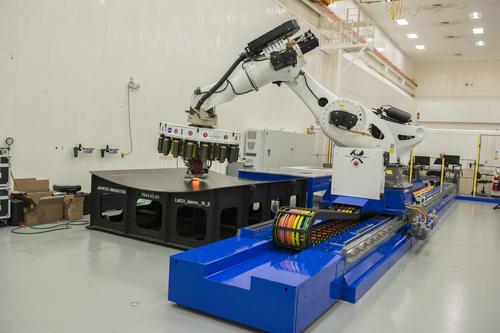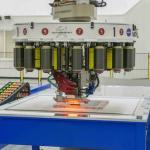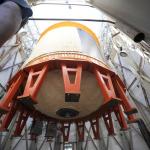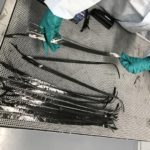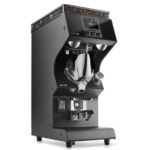Last December, we told you about a giant composites-making robot NASA installed at its Langley Research Center to do R&D for making better aerospace materials. Now, a similar robot has arrived at the agency’s Marshall Space Flight Center. But this one will be building the biggest composite parts ever made for space vehicles like NASA’s Space Launch System (SLS).
Both robots are huge, 21-ft long mechanical arms made by Electroimpact that precisely lay down an epoxy matrix and carbon fibers by sliding up and down a 40-ft track in preprogrammed patterns. The difference is primarily in how the two will be used, Chauncey Wu, senior research engineer at Langley Research Center, told Design News. Langley’s research robot, named ISAAC (Integrated Structural Assembly of Advanced Composites), is designed as a research platform to test out materials concepts. It will help NASA researchers investigate the use of composites for aviation, spacecraft, and launch systems, as well as reduce the time required for development, verification, and regulatory acceptance of new materials and structures.
Marshall’s new robotic arm is designed more as an operational robot to build large parts, said Wu. According to a news release, that robot will help researchers develop high-speed, less expensive manufacturing processes for making large composite rocket structures. As we reported last year, NASA has already developed and tested big composite parts for the SLS, such as a huge, 18-ft carbon composite cryogenic fuel tank.
The SLS is a heavy-lift rocket designed to take humans on deep space exploration missions to Mars and beyond. Every ounce saved in weight makes a big difference in how much payload it can carry and how long its fuel can last. But that’s not all. NASA also hopes to build other large spacecraft with composites, of 26 ft or more in diameter, such as landers, rovers, and habitats. At Marshall, the robot’s first project will be creating large composite structures for a Technology Demonstration Mission for the SLS.
The robot is being housed in Marshall’s Composites Technology Center, part of NASA’s National Center for Advanced Manufacturing. Electroimpact’s engineers helped Marshall engineers customize the robot and supporting software for building large space structures. The center contains a variety of support infrastructure for composite manufacturing, including large autoclaves, curing chambers, test facilities, and digital analysis systems.
Photo 1’s caption: NASA and Boeing co-developed this huge, 18-ft diameter carbon composite cryogenic rocket fuel tank for the Space Launch System. Its outer shell is the same size as propellant tanks in today’s rocket. The tank will save about 30% in weight and 25% in cost over metal tanks. (Source: Boeing)
Photo 2’s caption: NASA’s new 21-ft robot arm moves on a track in the Composites Technology Center of the agency’s National Center for Advanced Manufacturing at Marshall Space Flight Center. The robot’s head is dispensing hair-thin carbon fiber tape in precise patterns to make a large composite panel. (Source: NASA/MSFC/Fred Deaton)
Photo 3’s caption: The robot’s head releases 16 spools of composite fiber tape in precise patterns. As the fibers are released they are heated to adhere to various surfaces. The head can be changed out for different projects. (Source: NASA/MSFC/Fred Deaton)
Photo 4’s caption: Last year, NASA engineers tested the full-scale composite cryogenic rocket fuel tank, shown here in a test stand at Marshall Space Flight Center. (Source: NASA/MSFC/David Olive)


